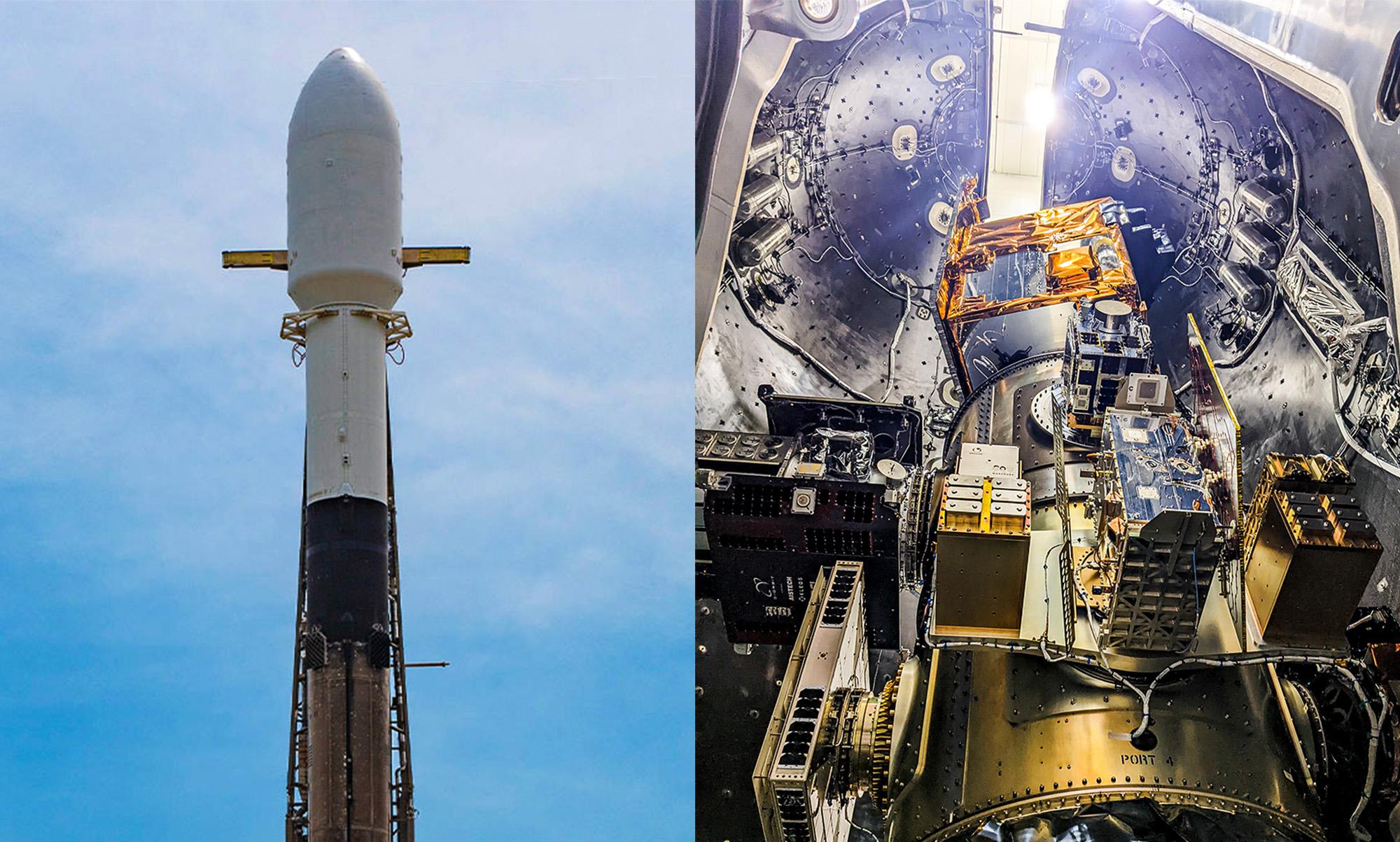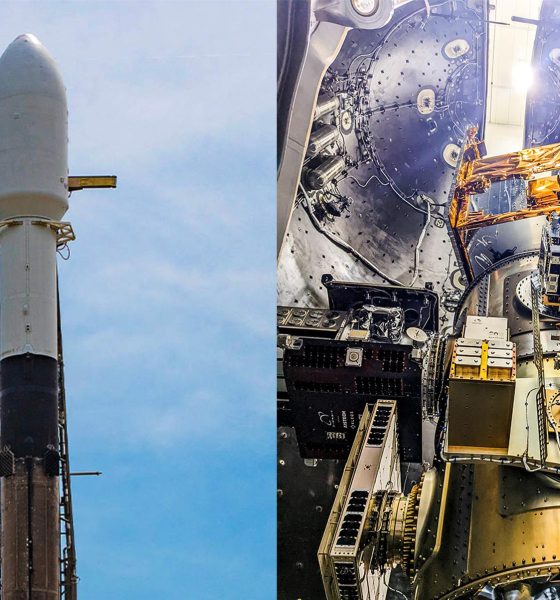

News
SpaceX set to launch 40 satellites on fourth dedicated rideshare mission
SpaceX says a Falcon 9 rocket is on track to launch its fourth dedicated rideshare mission no earlier than (NET) 12:24 pm EDT (16:24 UTC) on Friday, April 1st.
Known as Transporter-4, SpaceX will launch the batch of 40 customer satellites out of its Cape Canaveral Space Force Station (CCSFS) LC-40 pad. Poor weather means that the company currently has a roughly 30% chance of favorable conditions on April 1st, improving to 50% on April 2nd and 80% on April 4th. Following the first NASA Space Launch System (SLS) rocket’s trip to a nearby launch pad, SpaceX also has to work around the agency’s plans to attempt an important wet dress rehearsal (WDR) test as early as April 3rd, preventing any launches that day.
SLS has already partially contributed to delays to Axiom-1 – the first all-private astronaut launch to the International Space Station – and could potentially disrupt Transporter-4 if weather or Falcon 9 fail to cooperate on Friday or Saturday.
Transporter-4’s payload of 40 satellites is the smallest number SpaceX has ever manifested on one of its dedicated rideshare missions. It’s unclear why so few satellites will be aboard, but one customer in particular likely explains why the company can launch such a small payload. That customer is Germany’s national space agency (DLR), which has manifested EnMAP – a hyperspectral Earth observation satellite – on Transporter-4. EnMAP itself is quite a bizarre case: the wildly overambitious smallsat was initially scheduled to launch as early as 2012 but has suffered a full decade of delays as endless issues arose. Painfully, those delays mean that EnMAP – a spacecraft largely designed before 2010 – is merely the latest in a long line of similarly capable satellites. Italy, for example, began work on an almost identically capable spacecraft – PRISMA – in 2008 and launched it in 2019 for ~$140 million.
According to one estimate, EnMAP’s cost has likely ballooned from ~$100 million to more than $330 million. In other words, it’s fairly reasonable to assume that SpaceX was able to charge DLR quite a bit more than Transporter-4’s other rideshare customers. SpaceX could have positioned it as a heavily discounted dedicated launch that just so happens to carry some secondary payloads – perhaps charging ‘just’ $15-30 million. EnMAP (950 kg or 2100 lb) is slightly heavier than the maximum weight SpaceX’s one-size-fits-all pricing allows for, but a customer with a similar 830 kilogram (1830 lb) spacecraft could launch it for as little as $4.6 million on a Transporter mission.
Of Transporter-4’s 40 payloads, at least 16 are using intermediaries like Spaceflight, Exolaunch, and D-Orbit, who then deal with SpaceX for the satellite owners. Excluding EnMAP, at least six other customers likely booked directly through SpaceX. Combined, total Transporter-4 revenue before EnMAP could be as low as ~$13 million. According to a SpaceX executive speaking in 2020, the total cost of a Falcon 9 launch with a recoverable, flight-proven booster is $28 million. Given that some executives have compared Transporter missions to public transit, it’s possible that SpaceX is willing to launch some rideshare missions even knowing they will lose money, but it’s hard to imagine it would burn $10-15 million (or more) instead of just delaying a few months to add more payloads.
Even though EnMAP is thus likely picking up all of financial slack, Transporter-4 is still a good demonstration of SpaceX’s flexibility – flexibility that current or prospective providers with much smaller rockets simply can’t match. With Falcon 9, SpaceX can just throw a 1-ton, $300 million spacecraft on top of a several-dozen-satellite rideshare mission and still recover both the booster and fairing without issue – all while charging its smaller customers a more or less unbeatable $1.1 million per 200-kilogram slot and $5500 for each additional kilogram.
SpaceX will begin streaming its first Transporter-4 launch attempt around 12:10 pm EDT (16:10 UTC).

Cybertruck
Tesla updates Cybertruck owners about key Powershare feature

Tesla is updating Cybertruck owners on its timeline of a massive feature that has yet to ship: Powershare with Powerwall.
Powershare is a bidirectional charging feature exclusive to Cybertruck, which allows the vehicle’s battery to act as a portable power source for homes, appliances, tools, other EVs, and more. It was announced in late 2023 as part of Tesla’s push into vehicle-to-everything energy sharing, and acting as a giant portable charger is the main advantage, as it can provide backup power during outages.
Cybertruck’s Powershare system supports both vehicle-to-load (V2L) and vehicle-to-home (V2H), making it flexible and well-rounded for a variety of applications.
However, even though the feature was promised with Cybertruck, it has yet to be shipped to vehicles. Tesla communicated with owners through email recently regarding Powershare with Powerwall, which essentially has the pickup act as an extended battery.
Powerwall discharge would be prioritized before tapping into the truck’s larger pack.
However, Tesla is still working on getting the feature out to owners, an email said:
“We’re writing to let you know that the Powershare with Powerwall feature is still in development and is now scheduled for release in mid-2026.
This new release date gives us additional time to design and test this feature, ensuring its ability to communicate and optimize energy sharing between your vehicle and many configurations and generations of Powerwall. We are also using this time to develop additional Powershare features that will help us continue to accelerate the world’s transition to sustainable energy.”
Owners have expressed some real disappointment in Tesla’s continuous delays in releasing the feature, as it was expected to be released by late 2024, but now has been pushed back several times to mid-2026, according to the email.
Foundation Series Cybertruck buyers paid extra, expecting the feature to be rolled out with their vehicle upon pickup.
Cybertruck’s Lead Engineer, Wes Morrill, even commented on the holdup:
As a Cybertruck owner who also has Powerwall, I empathize with the disappointed comments.
To their credit, the team has delivered powershare functionality to Cybertruck customers who otherwise have no backup with development of the powershare gateway. As well as those with solar…
— Wes (@wmorrill3) December 12, 2025
He said that “it turned out to be much harder than anticipated to make powershare work seamlessly with existing Powerwalls through existing wall connectors. Two grid-forming devices need to negotiate who will form and who will follow, depending on the state of charge of each, and they need to do this without a network and through multiple generations of hardware, and test and validate this process through rigorous certifications to ensure grid safety.”
It’s nice to see the transparency, but it is justified for some Cybertruck owners to feel like they’ve been bait-and-switched.
News
Tesla’s northernmost Supercharger in North America opens

Tesla has opened its northernmost Supercharger in Fairbanks, Alaska, with eight V4 stalls located in one of the most frigid cities in the U.S.
Located just 196 miles from the Arctic Circle, Fairbanks’s average temperature for the week was around -12 degrees Fahrenheit. However, there are plenty of Tesla owners in Alaska who have been waiting for more charging options out in public.
There are only 36 total Supercharger stalls in Alaska, despite being the largest state in the U.S.
Eight Superchargers were added to Fairbanks, which will eventually be a 48-stall station. Tesla announced its activation today:
North America’s northernmost Supercharger Fairbanks, AK (8 stalls) opened to public. https://t.co/M4l04DZ6B5 pic.twitter.com/zyL6bDuA93
— Tesla Charging (@TeslaCharging) December 12, 2025
The base price per kWh is $0.43 at the Fairbanks Supercharger. Thanks to its V4 capabilities, it can charge at speeds up to 325 kW.
Despite being the northernmost Supercharger in North America, it is not even in the Top 5 northernmost Superchargers globally, because Alaska is south of Norway. The northernmost Supercharger is in Honningsvåg, Norway. All of the Top 5 are in the Scandanavian country.
Tesla’s Supercharger expansion in 2025 has been impressive, and although it experienced some early-quarter slowdowns due to V3-to-V4 hardware transitions, it has been the company’s strongest year for deployments.
🚨🚨 Tesla Supercharging had a HUGE year, and they deserve to be recognized.
🍔 Opened Tesla Diner, a drive-in movie theater with awesome, Chef-curated cuisine
🔌 Gave access to Superchargers to several EV makers, including Hyundai, Genesis, Mercedes-Benz, Kia, Lucid, Toyota,… pic.twitter.com/yYT2QEbqoW
— TESLARATI (@Teslarati) December 10, 2025
Through the three quarters of 2025, the company has added 7,753 stations and 73,817 stalls across the world, a 16 percent increase in stations and an 18 percent increase in stalls compared to last year.
Tesla is on track to add over 12,000 stalls for the full year, achieving an average of one new stall every hour, an impressive statistic.
Recently, the company wrapped up construction at its Supercharger Oasis in Lost Hills, California, a 168-stall Supercharger that Tesla Solar Panels completely power. It is the largest Supercharger in the world.
News
Tesla shocks with latest Robotaxi testing move
Why Tesla has chosen to use a couple of Model S units must have a reason; the company is calculated in its engineering and data collection efforts, so this is definitely more than “we just felt like giving our drivers a change of scenery.”

Tesla Model S vehicles were spotted performing validation testing with LiDAR rigs in California today, a pretty big switch-up compared to what we are used to seeing on the roads.
Tesla utilizes the Model Y crossover for its Robotaxi fleet. It is adequately sized, the most popular vehicle in its lineup, and is suitable for a wide variety of applications. It provides enough luxury for a single rider, but enough room for several passengers, if needed.
However, the testing has seemingly expanded to one of Tesla’s premium flagship offerings, as the Model S was spotted with the validation equipment that is seen entirely with Model Y vehicles. We have written several articles on Robotaxi testing mules being spotted across the United States, but this is a first:
🚨 Tesla is using Model S vehicles fitted with LiDAR rigs to validate FSD and Robotaxi, differing from the Model Ys that it uses typically
Those Model Y vehicles have been on the East Coast for some time. These Model S cars were spotted in California https://t.co/CN9Bw5Wma8 pic.twitter.com/UE55hx5mdd
— TESLARATI (@Teslarati) December 11, 2025
Why Tesla has chosen to use a couple of Model S units must have a reason; the company is calculated in its engineering and data collection efforts, so this is definitely more than “we just felt like giving our drivers a change of scenery.”
It seems to hint that Tesla could add a premium, more luxury offering to its Robotaxi platform eventually. Think about it: Uber has Uber Black, Lyft has Lyft Black. These vehicles and services are associated with a more premium cost as they combine luxury models with more catered transportation options.
Tesla could be testing the waters here, and it could be thinking of adding the Model S to its fleet of ride-hailing vehicles.
Reluctant to remove the Model S from its production plans completely despite its low volume contributions to the overall mission of transitioning the world to sustainable energy, the flagship sedan has always meant something. CEO Elon Musk referred to it, along with its sibling Model X, as continuing on production lines due to “sentimental reasons.”
However, its purpose might have been expanded to justify keeping it around, and why not? It is a cozy, premium offering, and it would be great for those who want a little more luxury and are willing to pay a few extra dollars.
Of course, none of this is even close to confirmed. However, it is reasonable to speculate that the Model S could be a potential addition to the Robotaxi fleet. It’s capable of all the same things the Model Y is, but with more luxuriousness, and it could be the perfect addition to the futuristic fleet.








